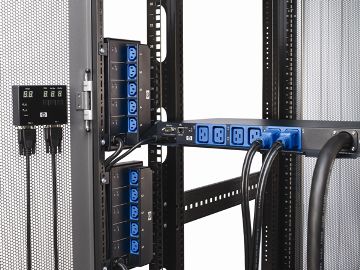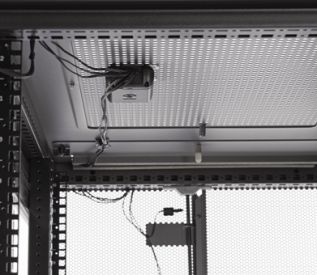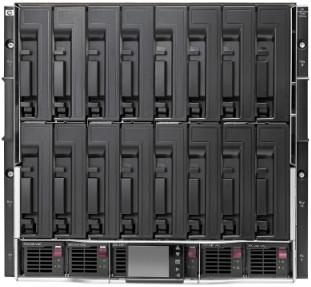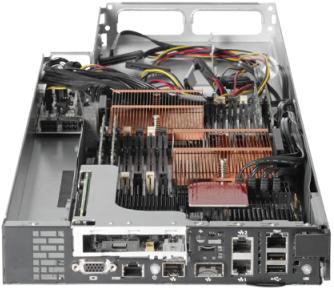HP, together with Eaton, is developing a modular data center commissioned by the US Department of Energy
As part of the program to upgrade the US energy infrastructure in 2009, the US Department of Energy provided HP with a grant of $ 7.4 million. The task was to create a technology for building a modular data center with a closed loop, to which cooling water and power supply are connected. The fact is that the widespread and cheapening of such technologies can favorably affect the energy efficiency of data centers and reduce carbon dioxide emissions around the world. The task was entrusted to HP tandem as an expert in server technologies and Eaton, which has extensive experience in creating energy solutions.
Grant funding needs to be spent on developing a closed loop module that includes equipment racks, a liquid cooling system, and power inlets for alternating current.
The project was launched in February 2010, the development period is 2 years. The money received from the ministry should cover 80% of the development cost, while the rest of the burden falls on HP and Eaton. The choice on HP was not a coincidence: the company already has its own modular cooling system, the HP Modular Cooling System, and a rather short time by the standards of the industry of two years in this case seems quite real.
')

 From a technical point of view, the MDC (modular data center) is based on rolling technologies and achieves the desired effect not with the help of previously not implemented technological moves, but due to the synergy of technical solutions. The designed module is designed for 100 kW of power supply and the corresponding level of heat sink. Water will be used as the refrigerant, and the electric circuit is designed to be powered by a high voltage of 400-480 V. To achieve maximum efficiency, high-voltage direct current is used to power the equipment. Power distribution is strictly controlled to optimize the use of MDC resources. The key parameters here are load distribution in the network, equipment requirements, peak and low load time depending on the element, as well as availability and amount of alternative power (remember about the sun and wind?). The module administrators have at their disposal means of active redistribution of power depending on the mode of operation of the IBC, and all systems, naturally, are equipped with an interface with a common power monitoring and cooling system, so that the whole cycle can be traced from beginning to end.
From a technical point of view, the MDC (modular data center) is based on rolling technologies and achieves the desired effect not with the help of previously not implemented technological moves, but due to the synergy of technical solutions. The designed module is designed for 100 kW of power supply and the corresponding level of heat sink. Water will be used as the refrigerant, and the electric circuit is designed to be powered by a high voltage of 400-480 V. To achieve maximum efficiency, high-voltage direct current is used to power the equipment. Power distribution is strictly controlled to optimize the use of MDC resources. The key parameters here are load distribution in the network, equipment requirements, peak and low load time depending on the element, as well as availability and amount of alternative power (remember about the sun and wind?). The module administrators have at their disposal means of active redistribution of power depending on the mode of operation of the IBC, and all systems, naturally, are equipped with an interface with a common power monitoring and cooling system, so that the whole cycle can be traced from beginning to end.


In MDC four, six or eight standard 42-unit racks are installed. Accordingly, the level of heat generation is from 12.5 kW per rack in the layout with eight cabinets to 25 kW in the version with four racks. The density of the installation requires a special organization of cooling - it is carried out using a special cooling system installed in a separate rack in the very center of the module. At the same time, the module is designed in such a way that two engineers could fully assemble it in two days by resorting to the help of an energy specialist and a specialist in connecting to the water supply.
It is noteworthy that, with a serious stuffing, the module has very humane dimensions - 7.3 m long and 1.8 m wide when installing eight racks and a cooling system.
It is expected that the effective economy of electricity will be 38% per 100 kW, and the energy efficiency index - 1.25. In a conventional modern data center, this index is about 2, that is, for every watt consumed by the equipment, the data center consumes another watt for cooling and power supply. Accordingly, with the use of MDC, the additional cost of electricity should be radically reduced.
 As of today, the first stage of the development of the IBC has been completed. The overall development process was divided into several periods: the period of evaluation (evaluation), the period of construction of the prototype (proto) and the launch of a pilot sample (pilot). At the end of 2010, HP conducted a sample of MDC with four racks. At all key points of the design, temperature and pressure sensors were installed to monitor the airflow in the module. To simulate the load, heating elements were installed in the racks - with their help, it is convenient to change operating modes without moving real equipment back and forth.
As of today, the first stage of the development of the IBC has been completed. The overall development process was divided into several periods: the period of evaluation (evaluation), the period of construction of the prototype (proto) and the launch of a pilot sample (pilot). At the end of 2010, HP conducted a sample of MDC with four racks. At all key points of the design, temperature and pressure sensors were installed to monitor the airflow in the module. To simulate the load, heating elements were installed in the racks - with their help, it is convenient to change operating modes without moving real equipment back and forth.
At the moment, the development process is in the Proto phase. At this stage, tests are conducted with real equipment and HP engineers are trying to simulate as many realistic situations as possible. The new servers are constantly increasing the level of heat generation per unit, especially against the background of the general trend towards compaction, therefore the IBC must have a serious “buoyancy margin” taking into account the use of servers and equipment of future generations. Also one of the important factors is the depth of the equipment. If there is not enough space in the hot corridor to completely remove hot air from the cooling system, it will recycle inside the rack, which is very harmful from the point of view of server cooling.


The prototype MDC will soon be available to another team of HP engineers responsible for the second phase of development. At this stage, testing will be carried out exclusively with real equipment, in particular, server baskets c7000 fully equipped with high-density servers of the BL series. Compared to the estimated sample, there will be an even greater number of sensors in the prototype, and refrigerant circuit control valves and counters will be added to measure circulation efficiency. For its part, Eaton is committed to providing a 360 V power supply scheme.
The work on the second phase of the design will be completed in June 2011. Actually, the project is not interesting for its utility to the US Department of Energy, but the fact that the developments in the creation of the MDC will make it cheaper and faster to create modular data centers installed in containers to accommodate the equipment room. This means that soon data centers will become more accessible, simpler and more convenient. Everyone will benefit from this, including manufacturers, users, application creators and anyone who needs serious power in a reliable harness quickly and relatively accessible.
Grant funding needs to be spent on developing a closed loop module that includes equipment racks, a liquid cooling system, and power inlets for alternating current.
The project was launched in February 2010, the development period is 2 years. The money received from the ministry should cover 80% of the development cost, while the rest of the burden falls on HP and Eaton. The choice on HP was not a coincidence: the company already has its own modular cooling system, the HP Modular Cooling System, and a rather short time by the standards of the industry of two years in this case seems quite real.
')

 From a technical point of view, the MDC (modular data center) is based on rolling technologies and achieves the desired effect not with the help of previously not implemented technological moves, but due to the synergy of technical solutions. The designed module is designed for 100 kW of power supply and the corresponding level of heat sink. Water will be used as the refrigerant, and the electric circuit is designed to be powered by a high voltage of 400-480 V. To achieve maximum efficiency, high-voltage direct current is used to power the equipment. Power distribution is strictly controlled to optimize the use of MDC resources. The key parameters here are load distribution in the network, equipment requirements, peak and low load time depending on the element, as well as availability and amount of alternative power (remember about the sun and wind?). The module administrators have at their disposal means of active redistribution of power depending on the mode of operation of the IBC, and all systems, naturally, are equipped with an interface with a common power monitoring and cooling system, so that the whole cycle can be traced from beginning to end.
From a technical point of view, the MDC (modular data center) is based on rolling technologies and achieves the desired effect not with the help of previously not implemented technological moves, but due to the synergy of technical solutions. The designed module is designed for 100 kW of power supply and the corresponding level of heat sink. Water will be used as the refrigerant, and the electric circuit is designed to be powered by a high voltage of 400-480 V. To achieve maximum efficiency, high-voltage direct current is used to power the equipment. Power distribution is strictly controlled to optimize the use of MDC resources. The key parameters here are load distribution in the network, equipment requirements, peak and low load time depending on the element, as well as availability and amount of alternative power (remember about the sun and wind?). The module administrators have at their disposal means of active redistribution of power depending on the mode of operation of the IBC, and all systems, naturally, are equipped with an interface with a common power monitoring and cooling system, so that the whole cycle can be traced from beginning to end.

In MDC four, six or eight standard 42-unit racks are installed. Accordingly, the level of heat generation is from 12.5 kW per rack in the layout with eight cabinets to 25 kW in the version with four racks. The density of the installation requires a special organization of cooling - it is carried out using a special cooling system installed in a separate rack in the very center of the module. At the same time, the module is designed in such a way that two engineers could fully assemble it in two days by resorting to the help of an energy specialist and a specialist in connecting to the water supply.
It is noteworthy that, with a serious stuffing, the module has very humane dimensions - 7.3 m long and 1.8 m wide when installing eight racks and a cooling system.
It is expected that the effective economy of electricity will be 38% per 100 kW, and the energy efficiency index - 1.25. In a conventional modern data center, this index is about 2, that is, for every watt consumed by the equipment, the data center consumes another watt for cooling and power supply. Accordingly, with the use of MDC, the additional cost of electricity should be radically reduced.
 As of today, the first stage of the development of the IBC has been completed. The overall development process was divided into several periods: the period of evaluation (evaluation), the period of construction of the prototype (proto) and the launch of a pilot sample (pilot). At the end of 2010, HP conducted a sample of MDC with four racks. At all key points of the design, temperature and pressure sensors were installed to monitor the airflow in the module. To simulate the load, heating elements were installed in the racks - with their help, it is convenient to change operating modes without moving real equipment back and forth.
As of today, the first stage of the development of the IBC has been completed. The overall development process was divided into several periods: the period of evaluation (evaluation), the period of construction of the prototype (proto) and the launch of a pilot sample (pilot). At the end of 2010, HP conducted a sample of MDC with four racks. At all key points of the design, temperature and pressure sensors were installed to monitor the airflow in the module. To simulate the load, heating elements were installed in the racks - with their help, it is convenient to change operating modes without moving real equipment back and forth.At the moment, the development process is in the Proto phase. At this stage, tests are conducted with real equipment and HP engineers are trying to simulate as many realistic situations as possible. The new servers are constantly increasing the level of heat generation per unit, especially against the background of the general trend towards compaction, therefore the IBC must have a serious “buoyancy margin” taking into account the use of servers and equipment of future generations. Also one of the important factors is the depth of the equipment. If there is not enough space in the hot corridor to completely remove hot air from the cooling system, it will recycle inside the rack, which is very harmful from the point of view of server cooling.


The prototype MDC will soon be available to another team of HP engineers responsible for the second phase of development. At this stage, testing will be carried out exclusively with real equipment, in particular, server baskets c7000 fully equipped with high-density servers of the BL series. Compared to the estimated sample, there will be an even greater number of sensors in the prototype, and refrigerant circuit control valves and counters will be added to measure circulation efficiency. For its part, Eaton is committed to providing a 360 V power supply scheme.
The work on the second phase of the design will be completed in June 2011. Actually, the project is not interesting for its utility to the US Department of Energy, but the fact that the developments in the creation of the MDC will make it cheaper and faster to create modular data centers installed in containers to accommodate the equipment room. This means that soon data centers will become more accessible, simpler and more convenient. Everyone will benefit from this, including manufacturers, users, application creators and anyone who needs serious power in a reliable harness quickly and relatively accessible.
Source: https://habr.com/ru/post/119530/
All Articles